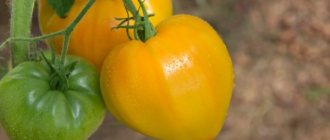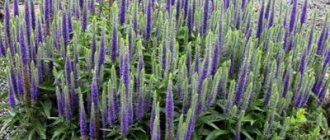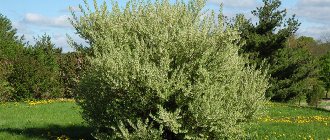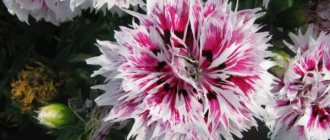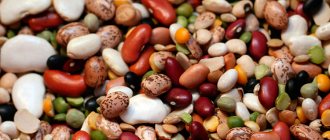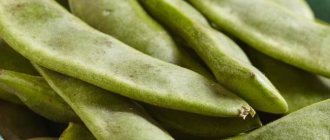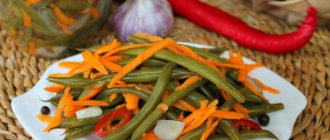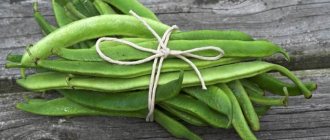If you have recently built a dacha or country house, but do not have time to do landscape design, you can effortlessly decorate your site with decorative climbing beans. Judge for yourself: an annual liana-like plant, fast-growing, unpretentious, with thick large leaves and bright flowers, entwining your arches and trellises almost all summer!
Long stems climb to a height of five meters, elegantly flowing onto nearby structures. And how the beans bloom... You will receive another bonus at the end of the flowering season, already in September, when you harvest a wonderful harvest of colorful beans from each plant!
Decorative climbing beans
Description and characteristics of decorative beans
Decorative beans are a collective name that combines several varieties of climbing beans from the legume genus:
- sugar,
- grain,
- semi-sugar.
Depending on the type of pods, it is also divided into shelling and asparagus.
- Hulled mature beans are stored without special processing. They can be used to prepare soups and main courses.
- Green beans should be consumed in an unripe state, since it is the juicy green pods with the rudiments of the beans that are edible. It is in this form that they are frozen for the winter, boiled and pickled.
Like other members of the genus, ornamental beans are capable of accumulating nitrogen in root thickenings, which significantly improves soil quality.
All varieties have very spectacular large flowers collected in inflorescences. The bean flower resembles a boat with a romantic white or colored sail. There are varieties with red, purple, white, two-color inflorescences, from which long, colorful edible pods grow by autumn.
Description of the plant
Typically, beans with bright red or purple flowers are grown in dachas. But in nature there are many more colors of this plant. Decorative beans grow very quickly. The length of the vine of many varieties reaches 5 m. As it grows, the plant clings to nearby objects and uses them as a support to rise towards the sun.
This plant is native to South America. The name translated into Russian means “sailing ship”. This is due to the special shape of the flower. After flowering, the fruits ripen in the form of large beans with a rough surface. They are used for planting next year.
Ornamental beans are heat-loving crops, but there is no need to create special conditions for their cultivation. It grows well in any area with good sunlight. In the shade, the vine will grow more slowly, but its flowering will not stop.
On a note! Although this vine is considered an ornamental, many varieties have edible fruits. But in most cases, they are still not eaten, preferring to grow ordinary varieties of beans.
Decorative beans saturate the soil with nitrogen. The plant extracts this element from the depths of the soil and air and processes it into a form suitable for absorption by other plants. The element accumulates in the root system. Therefore, after the end of the growing season, decorative beans are not removed from the soil. The green part is cut off, leaving the roots in the soil.
Due to the fact that beans improve the fertile qualities of the soil, potatoes grow well next to them. The green mass, cut in the fall, is placed in a compost pit to prepare fertilizer. Beans protect plants from the Solanaceae family from late blight, the Colorado potato beetle.
Optimal timing of planting seedlings and soil
Despite their unpretentiousness, legumes are very heat-loving, so they can be planted in the ground only when the soil warms up to +12. The timing of planting directly depends on the method of planting ornamental beans: seedlings or in open ground. In the south of the country, planting in the ground is carried out on April 10-15, in the north - on the May holidays. Legumes do not like transplants, so decorative climbing bean seedlings are grown in peat pots and transferred to open ground no later than mid-June.
Is this a food crop or just a flower crop?
It is a food and flower crop at the same time. All beans are edible except the purple variety. You can eat decorative beans; they contain zinc, magnesium, iron, chromium, calcium, proteins, fiber, carbohydrates, and vitamins. 100 g of product contains 26 kcal.
There are 2 types of climbing beans: grain and asparagus. The shelled type pod has an inner parchment layer, it is located between the beans. The pods grow tough and are not eaten.
Sugar green beans have soft and tender blades that are eaten unripe. The pods are juicy, crispy, sweet. Ripe fruits are used to plant beans, and various dishes are prepared from them. The seeds are smaller in size than grain varieties.
Planting methods
Planting and caring for a curly beauty will not be particularly difficult even for a person starting country life. The liana grows well in the open air, regardless of planting methods, and if you regularly water and care for it, your estate will be provided with a blooming appearance throughout the long summer! So what is the best way to sow and where to start? Let's consider two possible options.
Direct sowing into the ground
Before planting, the seeds are soaked for fifteen minutes in a light pink manganese solution. At this time, you can have time to level the loosened prepared soil, form rows at a distance of half a meter and dig holes at a distance of 30 cm from each other. Before sowing, the soil must be moistened. Place 2 beans in each hole 2 cm deep, sprinkle earth on top, and install a support.
Place 2 beans in each hole
For seedlings
You can start sprouting beans at home, where it is much easier to maintain the temperature regime suitable for a given crop at +18-+20˚C . Legumes really do not like transplants, so to avoid injury to the roots when moving the plant into open ground, you can buy special peat pots. To plant, you need to select the best undamaged beans, soak them in a 1% solution of potassium permanganate for 2 hours, then remove and dry. After disinfection, soak the seeds again in clean water until they swell.
Transplantation into the ground
We place the prepared seed in pairs in peat pots to a depth of 2 cm, and sprinkle the remaining soil on top. If the required temperature is maintained and watered regularly, the first shoots will appear in a few days. When 2 strong large leaves appear on the young plant, it can be transplanted into open ground together with the pot.
Planting seedlings in a garden bed
A month later, when 2-4 leaves appear, the seedlings are transferred to the garden. Before planting 5 days in advance, the bushes are left for 2 hours in the fresh air to harden, accustoming them to the external environment.
You may be interested in:
How to grow vegetable cowpea (Chinese beans) Have you never planted cowpea at your dachas? Hurry up and do it. A variety of Chinese green beans called...Read more...
You need to prepare the beds in advance. About a month before it gets warmer, humus or compost is added to the ground, but not fresh manure. Beans do not like clay soil. Sand, turf soil, and nutritional components are added to such soil. You can replenish the soil with mineral supplements. Phosphorus and potassium will be needed, nitrogen is optional if abundant flowering is desired. If you need an increase in green mass, then nitrogen will come in handy.
Scheme of planting seedlings:
- holes are dug along the fence or wall at a distance of 25-40 cm, between the rows (if there are any) a gap of 50 cm;
- install supports;
- holes are made according to the size of the pot, seedlings are buried without deepening;
- water with warm water 30-40*C;
- mulch the soil with straw, dry grass, sawdust.
Growing and care in open ground
Since young shoots are very sensitive to low temperatures, it is recommended to cover them with a homemade greenhouse for the first time. It is very simple to build from metal or plastic rods bent in a semicircle, which are covered on top with a large piece of polyethylene and pressed to the ground with stones or other available material. This shelter will allow the plants to grow stronger and adapt to life in the open ground until warm, comfortable weather sets in.
Watering and fertilizing
In order for the flowering vine to delight you all summer, it is very important not to let the soil dry out. You need to water moderately, strictly at the root, avoiding the stream of water getting on the buds. It is better to prepare warm, settled water in advance, for example, by pouring it into a watering can in the evening, or taking water from a barrel or other container adapted for this purpose. If you dry out the soil slightly during the process of setting buds, your plant will bloom much more actively. When the flowers have formed, continue watering as usual.
Watering beans
The climbing plant does not require feeding. It is enough to apply fertilizer no more than twice:
- when the first true leaves appear,
- when setting buds.
In both cases, potassium salts, urea solution, and superphosphate are added. You can use humus or compost for feeding, but not manure.
Weeding, loosening, mulching
Weeding, despite all our dislike for this process, must be carried out when growing any cultivated plant. This is especially important in the first month of life of decorative beans. When it grows a little and begins to curl, the plant needs to be hilled up and the vine should be laid in the direction you want. Then she herself will reach out to your support and wrap herself around it. To avoid frequent weeding and to maintain soil moisture, you can mulch it with sawdust, humus, and mown grass.
Garter
Decorative climbing beans, due to their properties of entwining and clinging to a nearby support, can do without a garter, but in this case the stems of the plant will intertwine and grow in a direction convenient for it. If you want to decorate some not very attractive surface with bean flowers or form a beautiful arch, you will still have to make a garter.
Wigwam support for decorative beans
Beans on trellises
To do this, you can use homemade mesh trellises 2 meters high or a wigwam support made of metal or wooden rods tied at the top. The lashes are tied to the support with thick twine or soft rope. For long-term use, you can invest in plastic clips, sold at any garden center.
Planting beans around a pyramid support
Diseases and pests
Even at the stage of selecting seeds for planting, we carefully examined each bean for the presence of round holes with passages made by larvae and beetles. This is a bean grain that multiplies in seeds during long-term storage. To prevent this disease, seed pods intended for seed are treated with metathione.
Bean grain
The most common diseases of ornamental beans are anthracnose and bacteriosis. The first signs of fungal anthracosis appear on the leaves of the plant in the form of brown spots, leading to yellowing and death of the leaf. All affected leaves are contagious, so they must be removed immediately to save the entire plant, and then spray the vine with a solution of Bordeaux mixture.
Bacterial damage to leaves - bacteriosis, manifests itself in the form of yellow spots, which later turn brown in the center. Treatment is carried out by analogy with anthracnose.
Care
Caring for beans is simple and includes systematic loosening of rows, weeding, fertilizing and watering. Loosening is carried out after each watering and rain; it is also combined with the removal of weeds. As the bushes grow, it will become increasingly difficult to loosen, so it is advisable to mulch the bed. When the bushes grow to 12–15 cm, they are lightly covered with earth.
Beans are a heat-loving plant, so if they were planted too early, at first you need to monitor the weather and, possibly, cover the plantings with non-woven materials. Alternatively, you can build a small temporary greenhouse. Mature plants can withstand temperatures close to 0°C.
How to water beans
Water all types of beans, including decorative ones, infrequently and moderately, avoiding drying out the soil. This should be done at the root, in the evenings, with water that has been settled and warmed by the sun during the day. In case of dry weather, watering is required twice a week.
It is advisable to direct the water directly to the roots, especially taking care not to soak the flowers and buds. Therefore, the strainer is often removed from the watering can so that the water gets between the rows or, when planting in a single row, closer to the base of the bushes.
Immediately before flowering begins, the soil can be slightly dried out for several days: this causes more buds to appear, but then watering continues as usual. It is better to mulch the soil around the beans with any bulk material (peat, humus, sawdust, chopped straw) to better retain moisture.
Top dressing
Feed decorative beans with any mineral or natural fertilizers, except fresh manure. Flower growers advise fertilizing it only twice:
- When two true leaves grow (per 1 m2, add 1 g of urea, 15 g of superphosphate and 10 g of any potassium salt).
- At the moment the buds appear (the same composition, excluding urea).
If it turns out that the flowering is not as lush as expected, perhaps the soil has become depleted, in which case more fertilizing should be done by mixing a handful of wood ash and a couple of tablespoons of superphosphate in a bucket of water, then let it stand for a day, dilute it with another 2 –3 times with water and water the plantings with this solution.
Is it possible to eat decorative beans?
In terms of taste and nutritional qualities, ornamental plants are practically no different from varieties grown on an industrial scale, so the answer to the question “is it possible to eat ornamental beans” is definitely positive. Asparagus species are eaten unripe and used for preparing salads, vegetable side dishes and soups. When frozen, they keep well all winter.
Right at the dacha, you can prepare, for example, asparagus decorative beans with mushrooms from the new harvest.
- For half a kilogram of mushrooms you will need the same amount of beans, a couple of onions and basil from the garden, black pepper, salt, a spoon of tomato paste (or fresh tomatoes), olive oil.
- Finely chop the onions of the new harvest, fry over low heat until golden brown, place peeled and chopped mushrooms in a frying pan, stir, fry at moderate temperature for another 10 minutes. Add salt and spices.
- Boil freshly picked green pods for 5 minutes in salted water, rinse in a colander, and pour into a frying pan with the mushrooms.
- Fry the resulting mixture for another 5 minutes, add thinly sliced tomatoes or tomato paste, stir, garnish with basil, and a delicious healthy dish of your own decorative beans is ready!
Asparagus beans with mushrooms
Unlike asparagus varieties, climbing grain varieties are used in their mature form, husking the beans from dried pods. You can make a delicious spicy bean soup from them right at your dacha.
Attention! Ripe beans will need to be soaked for 8 hours before cooking, so it’s best to do this in the evening.
So, we need to cook half a liter of vegetable broth:
- prepare 2 cups of beans,
- carrots,
- celery root,
- a teaspoon of freshly squeezed lemon juice,
- 2 potatoes,
- 1 onion from the garden,
- a few cloves of garlic,
- spices (cumin, pepper, salt),
- 2 tbsp. olive oil.
Cooking will take 2 hours, as the beans take a long time to cook. To the beans soaked in water, add another liter of water, as well as spices (salt, pepper, bay leaf), cook all this for an hour and a half until the beans are ready. At this time, finely chop and simmer all other vegetables in olive oil for 10 minutes. Add the prepared vegetables to the saucepan with the beans, add vegetable broth and lemon juice, cook for another quarter of an hour. Now you can try! An excellent first course of decorative beans!
This soup can be prepared in winter, as the fruits are perfectly stored in cabinets on the insulated loggia, and will remind you of the wonderful summer in the country.
Spicy bean soup
The best varieties of climbing beans with photos
All known varieties of garden beans differ in the size and color of the pods, and the shade of the flowers. Some belong to the asparagus variety, others belong to the common variety. The taste of the fruits themselves is almost the same in all varieties. What varieties of decorative beans look like is shown in the photo below.
Borlotto beans
This asparagus variety is native to Italy. It forms a beautiful, strong vine up to 3.5 m high with bright fiery flowers and tasty fruits. At the beginning of ripening, the beans have a green tint, but then a dark red marble pattern appears on their surface. There are up to 5 grains in one pod. The grains, which have not yet reached final maturity, are very tasty when boiled. As they ripen, they also become covered with marble stains. To eat these ornamental beans, the grains are harvested green 60 days after the plant is planted. Also, beans of this variety can be eaten as green beans. Then it is also picked unripe.
Green giant beans
This variety belongs to the asparagus variety. It differs from the others in its large pods, reaching a length of 22 cm. The fruits are very tender and sweet in taste, they do not contain coarse fibers or parchment. The length of the vine reaches 3 m. Fruiting begins after planting after 55 days and continues until the onset of frost. The flowers of this variety are small with a purple tint.
Cereal beans Violet
The length of the vine of this peeling variety reaches three meters. During the fruiting period, the plant produces long pods of a beautiful soft purple hue. At first the grains are green in color, but as they ripen they turn dark purple.
Bean, climbing golden nectar
This variety is classified as an asparagus variety. The length of the vine reaches 4 m. During the ripening period, the plant produces large pods up to 25 cm in length with a bright golden yellow color. They reach ripeness in 70 days. This variety is suitable for use in cooking, but only in its unripe form. To prepare dishes, take pods and individual beans.
Purple Queen Beans
This variety belongs to the asparagus variety. It forms a small vine up to 1.5 m long. During the flowering period, large purple flowers appear over the entire surface. Then, in their place, tubular beans of a dark purple color up to 18 cm long are formed. The variety ripens in 55 days with the formation of white beans.
Spanish white beans
The superiority of this variety is the huge size of tasty white grains. Its beans are 5 times larger than others, covered with a delicate thin shell. Spanish white is suitable for culinary purposes. Lobio, borscht, turche beans and other dishes are prepared from it. Only grains are eaten, except for short and wide pods. Spanish white beans mature in 72 days. The vine of this variety stretches up to 4 m in length, and during flowering it is covered with large white flowers.
Beans, Winner or Fire Red
This variety of ornamental red-flowering plant is most widespread for its unpretentiousness, abundant bright green foliage and large beautiful flowers. After ripening, the pod produces light purple flowers covered with black specks. Flowering time begins in June and ends in September. While the fruits are unripe, the beans are used like asparagus. After reaching maturity, only cooked grains are suitable for food. Raw ones contain toxic substances, but they are quickly destroyed as a result of heat treatment.
Climbing bean Bluehilda
This plant blooms with purple flowers, and later the same purple flowers appear in their place. Even the foliage changes color from green to purple over time. Bluehilda is a late variety. Its ripening period is 110 days. Therefore, in the regions of the Central zone, this plant is grown in seedlings. The flowering time for this bean begins early and continues until frost. Therefore, pods and flowers can be observed simultaneously on one vine. The pods of this plant are wide and do not contain coarse fibers or parchment. They are edible and can be cooked until they reach full ripeness. The grains are large and, when cooked, acquire a slight oiliness.
Bluehilda
An ornamental bean that begins to bloom very quickly: within a month or a month and a half after sowing, it is densely covered with lilac flowers. The bush is quite compact, up to 40 cm in height, so it can be grown even in areas where space is limited.
Related article:
How to save legumes until spring: 5 ways to store beans
Both the pods and the beans can be used as food because they are fiber-free, soft and tender. Another advantage is that the variety is resistant to specific diseases.
Bush
Bush beans are modest in size: the height of the bushes rarely exceeds half a meter. The yield of the varieties is also relatively low. However, bush beans are also not without advantages: they ripen quite earlier, and the yield is favorable.
Bush varieties are an ideal solution for farmers and growing crops on an industrial scale.
Aida Gold
The variety is excellent for growing both in open ground and in a greenhouse. The ripening period of golden-yellow pods and beans (which is why the variety got its name) directly depends on weather and climatic conditions. A distinctive feature is the preservation of the pods on the bush for a long time after ripening.
Aida Gold is characterized by relatively high yield, high taste and disease resistance. Designed for mechanized harvesting and processing.
Variety characteristics:
| View | Growing season, days | Planted, month | Plant height, cm | Pod length, cm |
| Semi-sugar | 70-90 | May June | 30-40 | 10-12 |
Ballad
The plant is covered with medium-sized round or diamond-shaped leaves and is decorated with pink flowers during the flowering period. Ballad beans are usually straight, medium-length and heart-shaped. Beige beans are covered with a purple pattern.
The variety is resistant to lodging, shedding, drought, diseases, especially bacteriosis. An additional advantage is the suitability of the Ballad for mechanized harvesting.
Variety characteristics:
| View | Growing season, days | Planted, month | Plant height, cm | Pod length, cm |
| Hulling (grain) | 77-105 | May June | 36-50 | 12-15 |
Bona
The robust, miniature bush is covered with fleshy, light green pods that contain several milky seeds.
Bona is a heat-loving plant, so it grows best in well-lit and warm areas. The variety is resistant to anthracnose and bean bacteriosis.
Variety characteristics:
| View | Growing season, days | Planted, month | Plant height, cm | Pod length, cm |
| Asparagus (vegetable) | 75-80 | the beginning of June | 30-40 | 12-14 |
Crane
The plant has green leaves and medium-sized white flowers. The beans are slightly curved, smooth, green in color. Crane seeds are elliptical in shape, white, and are widely used in cooking. The yield is relatively low, but the variety is extremely resistant to bacteriosis.
Variety characteristics:
| View | Growing season, days | Planted, month | Plant height, cm | Pod length, cm |
| Asparagus (vegetable) | 45-55 | late May-early June | 40–52 | 12-13 |
Cinderella
The variety boasts large bright pink flowers, and therefore is often used as an ornamental plant. The yellow oblong pods contain several white oval beans. Cinderella is popular due to its good yield and resistance to bacteriosis and anthracnose.
Variety characteristics:
| View | Growing season, days | Planted, month | Plant height, cm | Pod length, cm |
| Asparagus (vegetable) | 50-60 | late May-early June | 50-55 | 12-14 |
Inga
The variety is interesting for its productivity: with a tiny bush and small pod size, Inga has a fairly high yield compared to other representatives of bush beans. Other advantages of the variety include resistance to unfavorable growing conditions.
Variety characteristics:
| View | Growing season, days | Planted, month | Plant height, cm | Pod length, cm |
| Hulling (grain) | 45-65 | May June | 25-35 | 9-12 |
Indiana
The variety is notable for the color of its seeds - a red pattern is applied on the white “background” of the beans, which has common features with an Indian in a headdress.
Another feature of Indiana is the possibility of harvesting twice per season. The main condition is comfortable and, most importantly, warm climatic conditions.
Variety characteristics:
| View | Growing season, days | Planted, month | Plant height, cm | Pod length, cm |
| Asparagus (vegetable) | 60-70 | from mid-May | 40-50 | 15 |
Yin Yang
The unique color is the hallmark of the variety: black and white beans with a pattern imitate the famous symbol. In addition, for its small size, the variety has a fairly high yield, which has earned it love and respect among many gardeners and farmers.
Variety characteristics:
| View | Growing season, days | Planted, month | Plant height, cm | Pod length, cm |
| Hulling (grain) | 55-75 | from the end of May | 35-45 | 12-14 |
Caramel
The variety got its name due to the outstanding taste of not only the fruit, but also the green pod, which is completely devoid of a parchment layer.
High resistance to many viral diseases of beans is another undoubted advantage of Caramel.
Variety characteristics:
| View | Growing season, days | Planted, month | Plant height, cm | Pod length, cm |
| Asparagus (vegetable) | 50-60 | May | 30-40 | Up to 15 |
Royal purple pod
The variety probably received its royal name because of its white and pink stripes, slightly reminiscent of the colors of a tiger.
The advantages of the variety, in addition to the unique color, are the ability to grow in open ground, high yield and resistance to diseases.
Variety characteristics:
| View | Growing season, days | Planted, month | Plant height, cm | Pod length, cm |
| Asparagus (vegetable) | 60-75 | May June | 35-50 | 12 |
Little Red Riding Hood
The plant has white flowers, from which, over time, two-leaf beans with internal incomplete partitions develop, between which large seeds are located. The bean is white in color with a bright red spot near the eye, which is why it got its name.
The yield of the variety is high, the fruits ripen together. When heated, Red Riding Hood beans retain their original shape.
Variety characteristics:
| View | Growing season, days | Planted, month | Plant height, cm | Pod length, cm |
| Hulling (grain) | 95-100 | April-May, subject to frost protection | 25-35 | 10-12 |
Martin
The pods of the plant are medium in size. The variety's beans are snow-white, covered with bright purple spots.
Swallow beans are unpretentious, resistant to drought and a number of diseases that often affect the crop.
Variety characteristics:
| View | Growing season, days | Planted, month | Plant height, cm | Pod length, cm |
| Hulling (grain) | 65-75 | mid-May-early June | 30-40 | 15 |
Laura
Laura is a disease-resistant variety that successfully resists anthracnose and bacteriosis. A distinctive feature of this bean is its high yield.
Despite the fact that Laura is a fairly heat-loving and moisture-loving variety, it tolerates drought and other unfavorable conditions.
Variety characteristics:
| View | Growing season, days | Planted, month | Plant height, cm | Pod length, cm |
| Asparagus (vegetable) | 45-50 | May June | 35-45 | 9-12 |
Butter King
The variety, bred relatively recently, is suitable for cultivation both in open ground in temperate climates and in greenhouse conditions. Beans grow quite compactly: up to 35 bushes can fit in 1 square space.
Variety characteristics:
| View | Growing season, days | Planted, month | Plant height, cm | Pod length, cm |
| Asparagus (vegetable) | 50-65 | late May-early June | 30-40 | 25 |
Housewife's dream
The variety is characterized by stable and high yield, resistance to a number of diseases, especially ascochyta blight and anthracnose.
The housewife's dream is a fairly heat-loving variety that is drought-resistant and practically does not fall off.
Variety characteristics:
| View | Growing season, days | Planted, month | Plant height, cm | Pod length, cm |
| Asparagus (vegetable) | 64–86 | May June | 30-60 | 10-12 |
Nagano
Guest from Holland is perfect for open ground and hot climates. In low temperatures it is good to grow it in greenhouses. Unpretentious in care and resistant to diseases, loves loose, non-acidic soils.
Nagano beans have average yields.
Variety characteristics:
| View | Growing season, days | Planted, month | Plant height, cm | Pod length, cm |
| Hulling (grain) | 65-75 | May | 40-50 | 12-13 |
Note
Highest yield and short growing season Notes are the reasons why it is the most popular variety for cultivation on an industrial scale.
Variety characteristics:
| View | Growing season, days | Planted, month | Plant height, cm | Pod length, cm |
| Asparagus (vegetable) | 56-59 | May June | 35-40 | 15 |
Octave
It has small purple flowers, thanks to which it is often used by summer residents as a decoration for their lands. Octave is suitable for growing in open ground, especially in warm climates. It has good yield and resistance to bean diseases.
For preservation, it is better to give preference to another variety.
Variety characteristics:
| View | Growing season, days | Planted, month | Plant height, cm | Pod length, cm |
| Asparagus (vegetable) | 50-60 | May-early June | 25-40 | 17 |
Deer King
Beans with unusually tasty and nutritious grains. The pod is bright yellow, with white seeds.
With proper care and provision of comfortable conditions for the Deer King, you can harvest 2 harvests per season.
Variety characteristics:
| View | Growing season, days | Planted, month | Plant height, cm | Pod length, cm |
| Asparagus (vegetable) | 65-75 | May June | 35-45 | 15, curved |
Panther
One of the most popular and widespread varieties of vegetable beans. The variety is characterized by good yield, uniform fruiting and high resistance to anthracnose and bacteriosis.
The taste qualities of the variety are high.
Variety characteristics:
| View | Growing season, days | Planted, month | Plant height, cm | Pod length, cm |
| Asparagus (vegetable) | 46-70 | from mid-May | 35-40 | 12-16 |
Purple Queen
The variety is also known as Red Duchess and Purple Lady. A miniature (even by the standards of bush varieties) representative of the bean crop, it is valued by farmers for its ease of care and outstanding taste. Purple Queen does well and produces well in almost any soil.
The pods are colored intense purple, changing to dark green during heat treatment.
Variety characteristics:
| View | Growing season, days | Planted, month | Plant height, cm | Pod length, cm |
| Asparagus (vegetable) | 45-54 | late May-early June | 25-30 | 15 |
Ruby
Beans have a rich cherry-purple hue, which is preserved even during heat treatment. Thanks to this color, which has much in common with a precious stone, the variety got its name.
In addition to the aesthetic component, Ruby is popular among gardeners due to its high protein content and resistance to bacteriosis. At the same time, the variety is very demanding on the quality of the soil and the level of lighting.
Variety characteristics:
| View | Growing season, days | Planted, month | Plant height, cm | Pod length, cm |
| Hulling (grain) | 74–87 | late May-early June | 25-60 | 10-15 |
Sachs
The variety is valued for its good yield, since 1 axil can contain up to 10 pods. In addition, Saxa copes well with viruses and is resistant to bacteria and anthracnose. Beans have a high content of vitamin C and amino acids.
Variety characteristics:
| View | Growing season, days | Planted, month | Plant height, cm | Pod length, cm |
| Semi-sugar | 45-50 | late May-early June | 35-40 | 11-13 |
Second
The variety has juicy, fleshy beans, without a parchment layer and fiber. You can eat not only beans, but also milky juicy shells - the taste of Sekunda is excellent. The yield of the variety is also quite high.
At the same time, Secunda is quite picky: it needs a warm climate, moist soil, light structural soils and absolutely cannot tolerate fresh manure.
Variety characteristics:
| View | Growing season, days | Planted, month | Plant height, cm | Pod length, cm |
| Semi-sugar | 50-68 | end of May, no threat of frost | 32-37 | 7-8 |
Flamingo
A variety of green beans with variegated beans. The seeds ripening inside have a variegated color, decent quality and high nutritional value. Young shoulder blades are characterized by tenderness and juiciness, as well as a high content of protein and fiber.
Flamingo is a universal variety, unpretentious and at the same time stands out for its excellent yield.
Variety characteristics:
| View | Growing season, days | Planted, month | Plant height, cm | Pod length, cm |
| Asparagus (vegetable) | 55-60 | May June | 50-60 | 15 |
Chocolate girl
Brown beans, the color of milk chocolate with caramel, are the hallmark of the variety.
However, Shokoladnitsa is another capricious bush bean variety: it prefers nutritious, well-moistened soils, does not tolerate fresh manure, and at the same time takes root well in open ground.
Variety characteristics:
| View | Growing season, days | Planted, month | Plant height, cm | Pod length, cm |
| Hulling (grain) | 80-100 | late May-early June | 32-62 | 10-15 |
Use in landscape design
When growing decorative beans, vertical planes or special supports are needed, since this crop is capable of “climbing” to a height of up to 5 m. A chain-link mesh or ropes specially stretched on poles are suitable as a support. A wall that needs to be equipped with cords in advance is also suitable.
Climbing bean branches make an excellent decoration:
- vegetable garden;
- personal plot;
- yard;
- gazebos;
- fence
With this plant you can create a natural canopy that provides shade.
Ornamental beans are an amazingly beautiful plant that is grown not for tasty fruits, but for the purpose of decorating the site. And although the crop blooms for a long time and brightly, it is not picky in care, so it is suitable even for a novice gardener.
